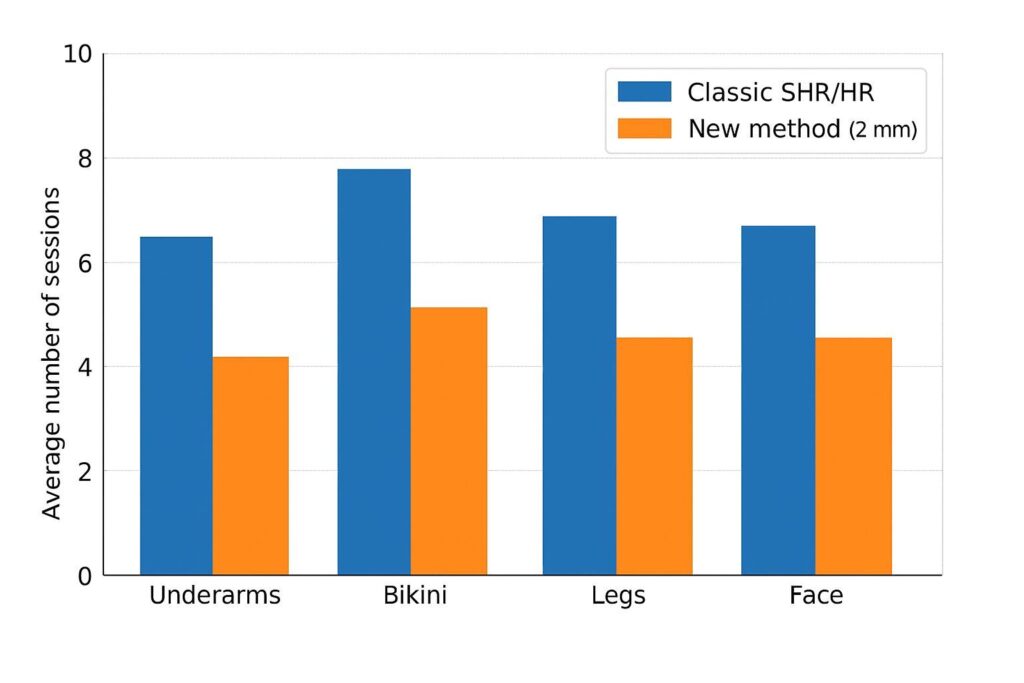Innovative Combined Hair Removal Technique: The Synergy of Laser and Wax for Maximum Efficiency
Laser and photoepilation remain among the most in-demand practices in aesthetic medicine worldwide. According to the analytical agency Global Market Insights, as early as 2023, the market volume was estimated at $1.13 billion, with a projected growth of 18.4% by 2032. Such demand highlights the need to develop new methods aimed at increasing both the efficiency of procedures and client comfort.
In this review, I present a comparative analysis of my developed combined hair removal method and the classical SHR (Super Hair Removal) and HR (Hair Removal) technologies, based on the data from my proprietary manual “Integrated hair removal method: using wax and laser in a single session.”
General description of the method
The dual-action method I propose is based on a combination of the most effective approaches used in modern cosmetology—laser hair removal and waxing—and consists of three consecutive stages:
- First stage: the selected area of skin is treated with a laser to maximally heat the hair shaft and transfer thermal energy deep into the follicle.
- Second stage: hypoallergenic wax is applied to the skin, removing the hair along with its root and opening the follicle opening to access deeper structures.
- Third stage: the same area is treated again with the laser, targeting the hair matrix and the nourishing blood vessels.
An important aspect: the second laser treatment must be carried out with adjusted laser parameters, using lower energy and a longer pulse. This ensures deep penetration of thermal energy while minimizing the risk of burns.
This method has already undergone practical testing with a large sample of clients—over 100 individuals. The results obtained allow for certain conclusions.
SHR/HR technologies act on the hair solely through the melanin in the hair shaft, which comes with a number of limitations. The combined method I developed effectively integrates this approach with direct action on the exposed follicle, achieving more pronounced results in a shorter time.
Comparison of results by skin phototypes
The analysis of the results indicates a reduction in the number of procedures by 15–30%, depending on the treatment area and the client’s skin phototype.
The most significant reduction—up to 30%—is observed in the underarm area for phototypes I–II, which correspond to very fair and fair skin. In absolute terms, this means a decrease in the number of sessions from 6–7 with SHR/HR methods to 4–5 sessions, respectively.
A 25% reduction is achieved for phototype III (leg area) and phototypes I–IV (facial area), with visible results after 4–6 sessions, whereas SHR/HR methods typically require 6–8 sessions.
A 20% improvement was observed when using my method for phototypes IV–V (bikini area) and phototype VI, which is characterized by very dark skin. It should be noted that a slight decrease in efficacy for the bikini area was expected—and even accounting for this, the number of sessions was reduced from 7–9 and 8–10 to 5–7 and 6–8, respectively.
Comparison of results by treatment area
The analysis of results obtained using my method on specific areas allows for the following conclusions:
- The most pronounced effect was observed in the reduction of hair on the arms and legs: hair reduction of 70–80% was achieved after just 3–4 sessions.
- Results in the facial area were more variable due to the hormonal dependence of hair growth. Nevertheless, most clients experienced noticeable thinning and slower growth after 2–3 sessions.
- In the underarm area, hair also responded more quickly to the dual-action method: the average number of sessions required to achieve visible results was 4–5 instead of the standard 6–8.
- The most challenging area was the bikini zone. Treatment here required more sessions—5–6. However, it is worth noting that this is still significantly fewer than what standard SHR/HR technologies require.

In conclusion, it can be confidently stated that the method I developed is highly effective and allows for achieving the desired results with fewer sessions, even when working on the most challenging and sensitive areas. It should be noted that the reduction in the number of procedures, increased client comfort, and personal savings—in both time and money—can, in the long term, help clinics and salons build a loyal client base, which may become a significant marketing advantage, especially in the competitive markets of the USA and Europe.
Finally, the method I developed has potential for further refinement and improvement—particularly through integration with modern systems for intelligent skin temperature control and automatic adjustment of laser hair removal device parameters.
Based on all of the above, it can be concluded that this method is promising and can be recommended for implementation in clinics and beauty salons, as well as for the development of corresponding training programs and manuals for specialists worldwide.
About the author
Viktoriia Sagdeeva is a unique specialist in the field of cosmetology, founder of the leading laser hair removal salon in Miami, Tori Beauty Space, and winner of the National Business Awards in the category “Leader of Innovation in Cosmetology.” In her work, she combines a client-oriented approach with the use of advanced technologies and techniques. The main result of her practical activity is the development of an original laser hair removal method that reduces the number of procedures, increases client comfort, and strengthens their loyalty. The presented article provides a comparative analysis of this innovative method and traditional technologies used for various skin phototypes.












